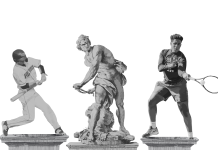Head track and field coach Nick Homan comes to terms with rare illness and finds passion for coaching.
Sprinting to the bar about three times taller than him, Nick Homan launched all 195 pounds of himself over it to land on the soft cushion below. The long, flexible pole helped him temporarily fly while twisting and turning his body.

It was February 2020 and Homan was competing to qualify for pole-vaulting in the Olympic Trials. With only an inch and a half away from qualifying, Homan left the meet determined to train harder and make the trials in the next couple years.
However, this never happened. This was the last time Homan competitively pole vaulted.
It only took two months for Homan’s life to drastically change from competitive athlete to struggling to make it up the stairs in his home.
Homan was diagnosed with Sarcoidosis, more specifically Nuero-Sarcoidosis. Only 5% of patients experience nervous system involvement (Nuero-Sarcoidosis). Sarcoidosis is primarily in the lungs and rarely in the brain. His condition meant the disease had traveled further out into the body. Homan’s condition created a mass in his spinal cord, which is extremely rare.
Homan’s illness is so rare that there are fewer than ten confirmed cases, leaving a lot of uncertainty about the disease. At the time of his diagnosis, there were only five confirmed cases.
“Everything is somewhat experimental,” Homan said.
Homan was in the hospital for 14 days. His vertical jump two months prior to his diagnosis was 42 inches. In the hospital, he could barely jump six inches off the ground. He had lost 40 pounds and struggled to walk up the stairs.
“[My time in the hospital] was tough. What I have is so rare, the doctors didn’t really know anything,” Homan said. “I never worried too much. The whole time I was in the hospital, in the back of my head was ‘this is temporary.’”
About six to eight months in, Homan realized his condition was not temporary, despite the fact that 60% of people do recover from Sarcoidosis.
“I started to realize I had to get used to it. Which it’s hard to say, because it is not possible to just get used to it,” Homan said. “It’s like a foreign feeling when things in my body start to flare up. There are days where I will go from feeling like my old self and then out of nowhere my legs are gone. I know it’s there, but I’ll never get used to it.”
Homan originally got into pole vaulting because his track coaches did not know where else to put him. He was a small eighth grader, weighing about 80 pounds and was 4-foot-8inches tall. He started pole vaulting for fun and competed in high school.
Homan watched countless YouTube videos on pole vaulting and coached himself into the athlete he was. He did not have an official coach until his last few years of college. Homan built all his muscle and started to get stronger and taller. It was a slow process, but he molded himself into an All-American athlete.
Nearing the end of his high school career, Homan had a track scholarship to Southeast Missouri State University. He was on track to achieve his dreams of becoming an Olympic athlete. However, when his mother became ill, he decided to choose family over his passion and take a few years off from the sport. He stayed at home and took care of his mom. For those years, Homan believed he was done with pole vaulting and hung up his spikes. After deciding that becoming an EMT was not for him, he worked at a call center job for a while.
It was not until one random morning that pole vaulting started to consume his mind again. He started watching pole vaulting videos and realized that something was missing from his life. He emailed almost every college in the area, trying to convince them to give him a chance. Hannibal-LaGrange University took an interest in him and Homan attended the college for one year. After that, he transferred to Central Methodist University, where he pole vaulted for three years and later became a coach.
In 2020, Homan was at his peak. He was jumping over 18 feet and was on track for the Olympic Trials. This was within two months of diagnosis.
He felt confident in his abilities, until everything started crashing down on him.
Homan started to notice small things happening to his body. There were always some things in his career which held him back or challenged him. After hurling his body over the bar five or six times, his legs started to feel weaker. They were not necessarily numb, he knew his legs were doing what he told them to do, but he could not quite feel the motions. In his head, he would shrug it off and tell himself he was overtraining and maybe just having a bad day.
Homan was not overtraining or having a bad day. His illness had been slowly affecting him for years.
It had gotten to the point where the mass in his spinal cord was so big, it made parts of his stomach and back go completely numb.
“You could poke me with a pen, and I would not feel a thing,” Homan said.
For the first six months after being diagnosed, Homan was in physical pain almost every other morning. He could not work, his energy was extremely low and his life consisted of going to lots of doctor’s appointments.
“I was either at the hospital or I was at home,” Homan said. “It affected my mental health for a while.”
His doctors had him on steroids and chemotherapy. The chemo did not cause as strong side effects as it would for cancer patients, but afterwards Homan would crash mentally and physically for a day or two. However, the treatment shrunk the mass in his spinal cord significantly. In August, he stopped the chemo treatments and was at 170 pounds but will likely start a different chemo drug later.
“Over the summer, when we stopped doing the chemo treatments, the doctor told me that where I was at now was going getting really bad again. If I push a little too hard, I could have three miserable days because of it,” Homan said.
The athletes he coached at CMU helped Homan immensely in his adjustment to his new life. They filled up his time by sending training progress or just checking in on him. His athletes would not allow Homan to back away from the sport and solidified his love for coaching.
“I quickly found myself getting more excited for their accomplishments than anything I could have done,” Homan said.
Slowly, Homan is starting to get back to himself. He is still not close to his old strength, but on a normal week, he can workout three times. On a good week, he can do four.
He gained a lot of his weight back, now weighing 185 pounds. He still pole vaults with caution, but no longer at the competitive level due to the effects sprinting has on his body. It is also hard for Homan mentally to feel the effects of his illness when he pole vaults. Through trial and error, Homan can somewhat tell how far he can physically push himself without repercussions.
Homan knows that nothing could ever replace his love for training and competing in the vault, but coaching has helped regain what he lost.
“There are times where it gets tough watching my peers pole vault, but I am at a point now where I’m pretty happy with where I am at,” Homan said. “It’s not too bad.”
Homan also found a bit of relief to finally know why he had so many problems during his career. He was constantly changing how he trained, his diet, supplements and even talking to therapists to help fix the problem.
“At least I know there was nothing else I could do,” Homan said. “My only fear throughout my athletic career was to wake up in 10, 20 or 30 years and think I could have given more.”




